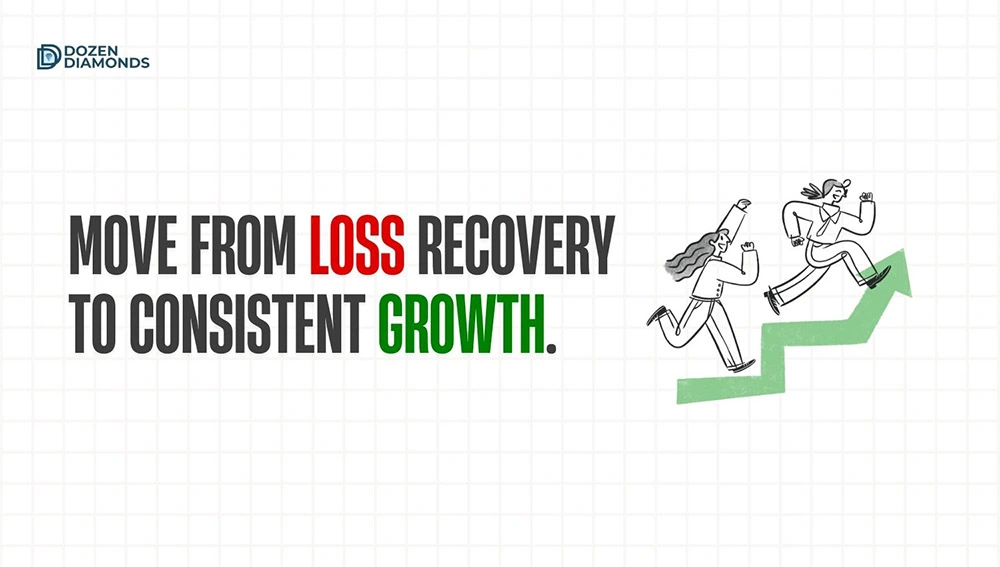Investment Strategy: How to Recover Loss in Stock Market

Table of Contents
Introduction: Why Most Investors Struggle with Loss Recovery
Every investor dreams of consistent profits, yet the reality of the stock market tells a different story (Investment Strategy). Even seasoned traders face periods of drawdown, where losses wipe out months or even years of gains. The real challenge isn’t just making profits—it’s knowing how to recover loss in stock market without panic-driven mistakes.
Most investors turn to aggressive averaging, chasing penny stocks, or relying on “hot tips.” Unfortunately, these approaches rarely work. What they lack is a structured investment strategy—one that removes emotions, ensures systematic recovery, and works across market cycles.
This is where the Stressless Trading Method (STM) powered by the Kosh App emerges as a proven framework designed for retail investors seeking reliable loss recovery.
What Does a Proven Investment Strategy Look Like?
An effective investment strategy isn’t just about timing entries and exits. It needs to answer three critical questions:
- Can it help me recover losses systematically?
- Does it protect me from emotional decision-making?
- Is it transparent, measurable, and replicable?
Most strategies fail because they are either too complex (multi-strategy algos), too vague (buy & hold without recovery planning), or too emotional (stop-loss-based panic selling). A proven investment strategy should combine automation, transparency, and recovery assurance.
Why Emotional Trading Fails in Loss Recovery
When investors face losses, the natural human response is fight or flight:
- Fight mode: doubling down, averaging aggressively, and holding onto losing stocks.
- Flight mode: panic-selling at the bottom, locking in losses, and missing rebounds.
Both modes are rooted in emotion, not logic. This explains why over 80% of retail traders fail to sustain profitability over the long term.
Without a structured investment strategy, recovery becomes a game of luck, not discipline.
The Stressless Trading Method (STM) – A Smarter Investment Strategy
The Stressless Trading Method is designed as a white-box algorithm that is fully transparent, algo-based, and tested across volatile market phases. Unlike black-box trading systems that hide behind complexity, STM lays out its recovery framework clearly:
- Automated, stressless execution – eliminates emotional decisions.
- Loss recovery mechanism – built to systematically recover drawdowns.
- White-box transparency – investors know exactly how and why decisions are made.
This makes STM not just another investment strategy, but a complete framework for financial resilience.
How STM Powered by Kosh App Helps You Recover Stock Market Losses?
Here’s how it helps:
- 1. Loss Recovery Framework – If your portfolio goes into the red, STM systematically executes trades designed to accelerate recovery.
- 2. Detachment from Emotion – No panic, no over-averaging, no revenge trades.
- 3. Algorithmic Consistency – Trades are executed with precision, regardless of market noise.
- 4. Transparency – You see the “why” behind every decision, unlike most algo platforms.
Key Benefits of Using STM as an Investment Strategy
1. Loss Recovery Framework
Unlike stop-loss methods that cut your position at a loss, STM is engineered to recover capital intelligently through built-in loss recovery mechanism & systematic execution.2. Stressless Trading
Investors are their own worst enemies during drawdowns. STM’s automation ensures that fear and greed are completely removed from decision-making.3. Transparent White-Box Algorithm
Unlike black-box algorithms, STM’s methodology is clear and explainable. This builds trust and confidence in the process.Comparing STM with Other Popular Investment Strategies
| No | Strategy | Strengths | Weaknesses | STM Advantage |
|---|---|---|---|---|
| 1 | SIP (Systematic Investment Plan) | Long-term wealth creation | No active loss recovery | STM actively recovers losses |
| 2 | Stop-Loss Strategy | Limits downside risk | Locks in losses permanently | STM uses built-in loss recovery mechanism |
| 3 | Averaging Down | Lowers cost per share | High risk if stock keeps falling | STM uses Extra Cash that covers up the loss |
| 4 | Algo Multi-Strategy | Sophisticated automation | Black-box, confusing for retail investors | STM is simple & transparent |
Real-Life Scenarios: Recovering Losses with STM
Imagine you bought a stock at ₹100. Due to a market downturn, it falls to ₹70. A stop-loss strategy would exit you at a 30% loss. Averaging down without rules could trap more capital.
STM, on the other hand, applies structured, rule-based recovery:
- Instead of panicking, it automates the execution and invests at every movement
- Generates Extra Cash with every executed order
- Systematically reduces your average cost while controlling risk.
The result? Stressless loss recovery while generating consistent monthly income
What Other Trading Solutions Miss About “How to Recover Loss in Stock Market?”
When you search online, most solutions suggest vague tips like “be patient,” “diversify,” or “don’t panic.” While true in theory, these aren’t actionable strategies.
What they miss is a concrete, algorithm-driven framework—something retail investors can actually implement.
STM fills this gap by offering an investment strategy designed specifically for loss recovery, not just generic advice.
Next Steps: How You Can Apply STM Today
Recovering losses isn’t about shortcuts or risky bets—it’s about discipline and a proven method. The Stressless Trading Method (STM) provides exactly that:
- Automated, stressless execution
- Structured loss recovery framework
- Transparent white-box algorithm
Ready to experience a smarter investment strategy?
Discover how STM on the Kosh App can help you recover market losses and grow with confidence.
👉 Join the Stressless Wealth Community: https://chat.whatsapp.com/B79yCAm61fOH00Ip2DEWjd
❓ FAQs on Investment Strategy
- Structured Loss Recovery: Recover from drawdowns systematically without panic.
- Stressless Trading: Automated execution removes fear and greed from decisions.
- Transparent Algorithm: White-box logic ensures every trade is understandable and replicable.
- Consistent Growth: Enables predictable income and long-term capital protection.